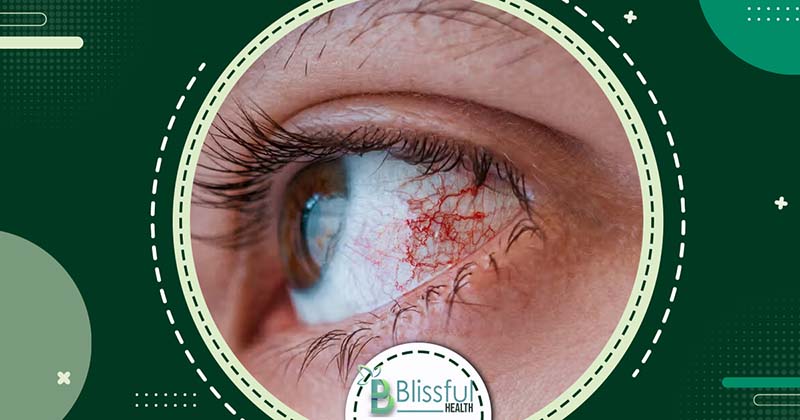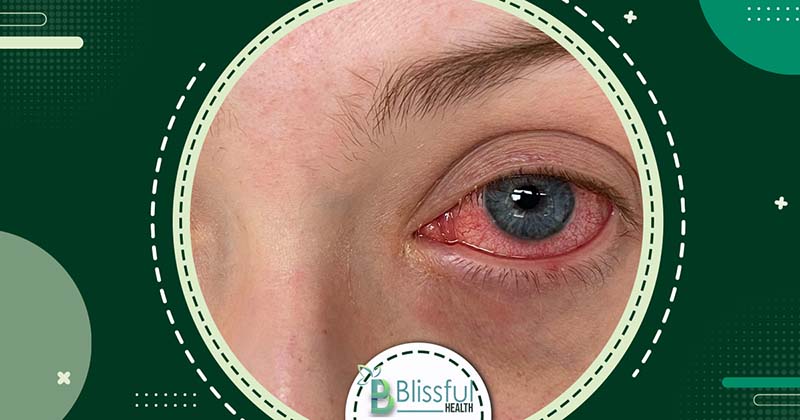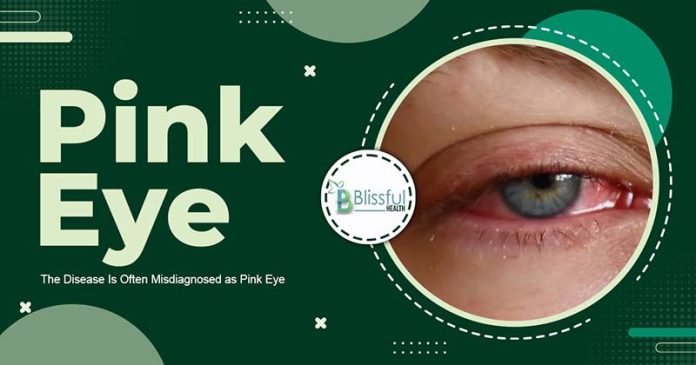The Disease Is Often Misdiagnosed as Pink Eye? If you notice the whites of your eyes are pink or red, it could mean you have pink eye, also called conjunctivitis. While using eye drops or medications can often help reduce inflammation, it’s important to think about other reasons for red eyes.
Allergies, dry eye syndrome, COVID-19-related pink eye, iritis, keratitis, stye or blepharitis are some factors that can look like pink eye. Therefore, it is important to differentiate them to get the right treatment.
Depending on the reason your eyes are red, you may need emergency eye care. Blissfulhealth can help you learn and knowing the signs of pink eye and other similar problems is important for quick and effective treatment. Let’s explore more about pink eye and what makes it different from other conditions.
What Is Pink Eye? Overview of Pink Eye
The conjunctiva is a thin, clear membrane that covers the outer surface of the eyeball and the inside of the eyelid. Its job is to produce mucus and tears, keeping the eye lubricated and safeguarded against outside irritants and germs.
When the conjunctiva becomes inflamed, it causes the white part of the eyeball (sclera) to appear pink or reddish, a condition commonly known as pink eye or conjunctivitis. Most cases of conjunctivitis are caused by viral or bacterial infections, although it can also develop due to eye irritation or injury.

Recognize the Symptoms of Pink Eye
Pink eye can manifest different symptoms depending on whether it’s bacterial, viral, or allergic. Look out for:
- Redness in the eye
- Feelings of grittiness or something stuck in your eye
- Itchiness
- Burning sensation
- Swollen eyelids
- Watery or discharge from the eye
- Blurry vision
- Sensitivity to light
- Mild pain
What Cases Are Often Misdiagnosed as Pink Eye?
Eye redness, irritation, and discharge are typical signs of pink eye. However, these symptoms can also occur in other eye conditions.
Allergies:
Exposure to allergens like pollen, dust, or pet dander can trigger allergic conjunctivitis. Histamine release due to allergies causes inflammation, leading to redness, itching, burning, and swollen eyelids. Nasal symptoms like sneezing and a runny nose may accompany eye discomfort.

Dry Eye Syndrome:
Inadequate tear production or poor-quality tears can result in dry eye syndrome. This can cause eye inflammation, redness, and irritation, resembling conjunctivitis symptoms. Seeking medical attention is crucial for accurate diagnosis and treatment.
COVID Pink Eye:
Some individuals with COVID-19 may develop red eyes, affecting a small percentage of noncritical hospitalized patients.
Iritis:
Inflammation of the iris, called iritis, shares symptoms like redness, eye discomfort, light sensitivity, and vision impairment with pink eye. It can affect one or both eyes and has various causes, including injury and underlying medical conditions.

Keratitis:
Corneal inflammation, or keratitis, presents symptoms similar to pink eye, including eye pain, hazy vision, redness, excessive tearing, and light sensitivity.
Stye:
A painful bump on the eyelid edge, called a stye, resembles a pimple or boil. It forms due to bacterial infection in eyelid oil glands, causing discomfort similar to pink eye.
Blepharitis:
Inflammation of eyelid oil glands, or blepharitis, leads to redness, discharge, tearing, light sensitivity, blurred vision, and crust formation, resembling pink eye symptoms.
If you experience any eye discomfort or vision issues, consulting a doctor is essential for an accurate diagnosis and appropriate treatment.
Why Are Other Diseases Often Mistaken for Pink Eye?
Other diseases are frequently confused with pink eye, also called conjunctivitis, mainly because many eye conditions share similar symptoms. Conjunctivitis is characterized by eye redness, swelling, itching, and discharge—symptoms that aren’t exclusive to this condition alone. For example, conditions like blepharitis (eyelid inflammation), dry eye syndrome, or corneal ulcers can also display these signs, leading to potential misdiagnosis.
The causes of pink eye—such as viruses, bacteria, allergies, or irritants—also trigger other eye problems, adding to the confusion. Allergic reactions can result in both allergic conjunctivitis and allergic blepharitis, making it challenging for non-specialists to differentiate them based solely on symptoms.
Diagnostic practices further complicate matters. Pink eye is often diagnosed based on clinical observation rather than specific laboratory tests. This approach may overlook other conditions because the initial symptoms might superficially suggest conjunctivitis. Without precise tests, distinguishing between various eye ailments becomes challenging.
Moreover, the prevalence of pink eye contributes to its frequent misdiagnosis. It’s one of the most well-known eye conditions, often leading both healthcare providers and patients to prematurely assume its presence when typical symptoms like eye discomfort or redness are reported. This assumption might hinder a thorough investigation into less common eye disorders requiring different treatments.
Lastly, public awareness plays a role. Since pink eye is widely recognized compared to other eye diseases, individuals might self-diagnose without professional input, relying on a general understanding of its symptoms. This emphasizes the importance of consulting healthcare professionals for accurate diagnosis and appropriate treatment, especially when experiencing eye symptoms.
Steps to Protect Eye Health
To safeguard your eye health, consider these essential steps:
- Schedule regular eye exams: Regular check-ups, especially for those aged 60 and above or at higher risk of eye diseases, are crucial. A comprehensive dilated eye exam can detect early signs of damage or disease in the macula, retina, and optic nerve.

- Maintain a balanced diet: Incorporate fruits and vegetables, particularly dark leafy greens, into your meals. These foods are rich in antioxidants like lutein and zeaxanthin, which can help prevent cataracts. Omega-3 fatty acids found in fish like salmon, halibut, and tuna also promote eye health.
- Wear protective sunglasses: Opt for sunglasses that block 99-100% of UVA and UVB radiation to shield your eyes from harmful UV rays. This can reduce the risk of eye diseases such as cataracts, sunburn, and eye cancer.

- Take breaks from screens: Prevent digital eye strain and nearsightedness by following the 20-20-20 rule: every 20 minutes, look at something 20 feet away for at least 20 seconds.
- Exercise regularly: Physical activity promotes healthy blood vessels and reduces the risk of glaucoma
- Quit smoking: Smoking increases the risk of eye diseases like macular degeneration and cataracts. Quitting can help lower this risk.

- Use protective gear: Wear safety glasses or goggles when working with hazardous materials or participating in sports that could cause eye injury. This simple precaution can prevent serious damage to your eyes.
Receive Accurate Instructions and Diagnosis from Your Doctor for the Best Treatment Results
It’s advisable to consult a doctor if:
- Your symptoms persist for several days without improvement.
- You exhibit symptoms of an eye infection, such as increased redness, pain, or discharge.
- You’ve sustained an eye injury, regardless of severity.
- Your symptoms may be associated with a chronic medical condition, like an autoimmune disease.
Seeking professional medical advice ensures accurate diagnosis and appropriate treatment, leading to the best possible outcomes for your eye health.
Conclusion
The Disease Is Often Misdiagnosed as Pink Eye While redness, blurriness, and wateriness are typical symptoms of pink eye, they can also indicate other underlying conditions. Therefore, consulting a doctor is essential to identify the root cause and receive appropriate treatment. Seeking professional medical advice ensures accurate diagnosis and helps address the issue effectively, promoting optimal eye health and well-being.


